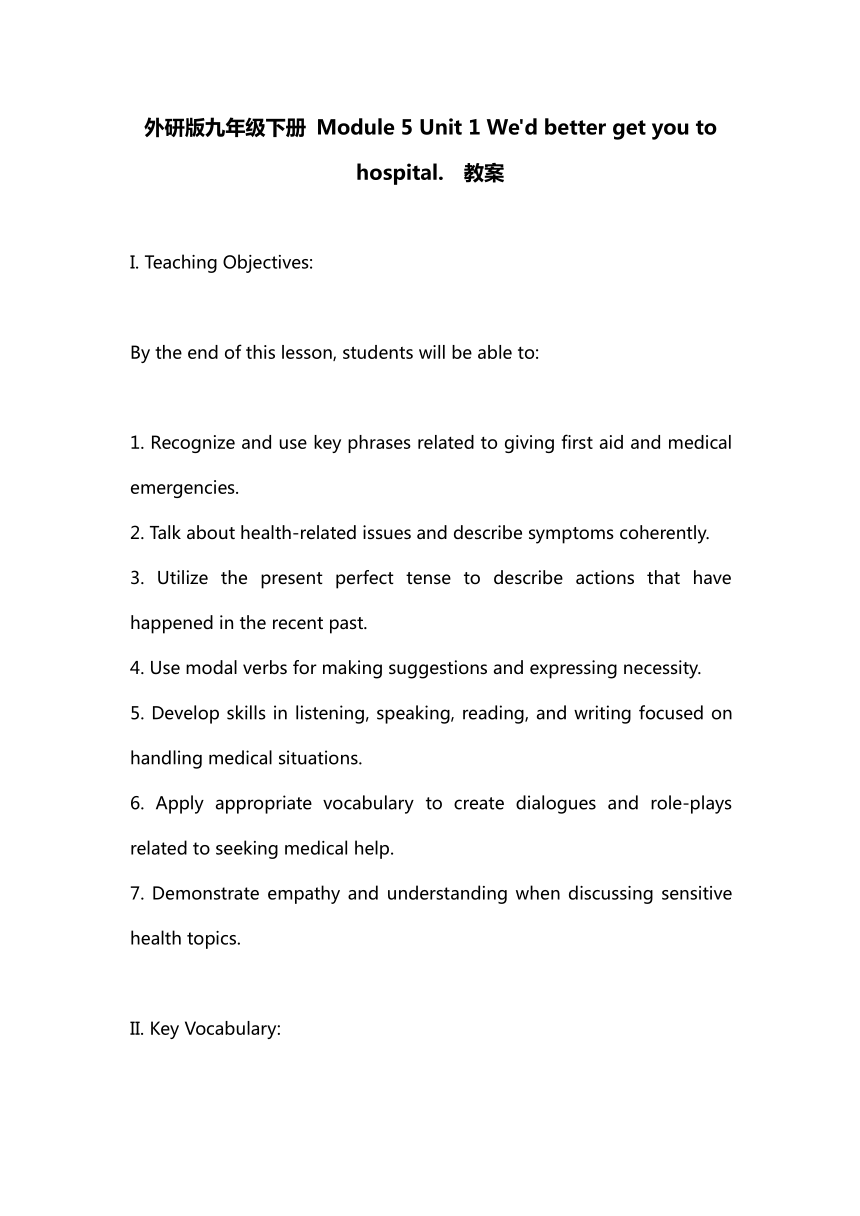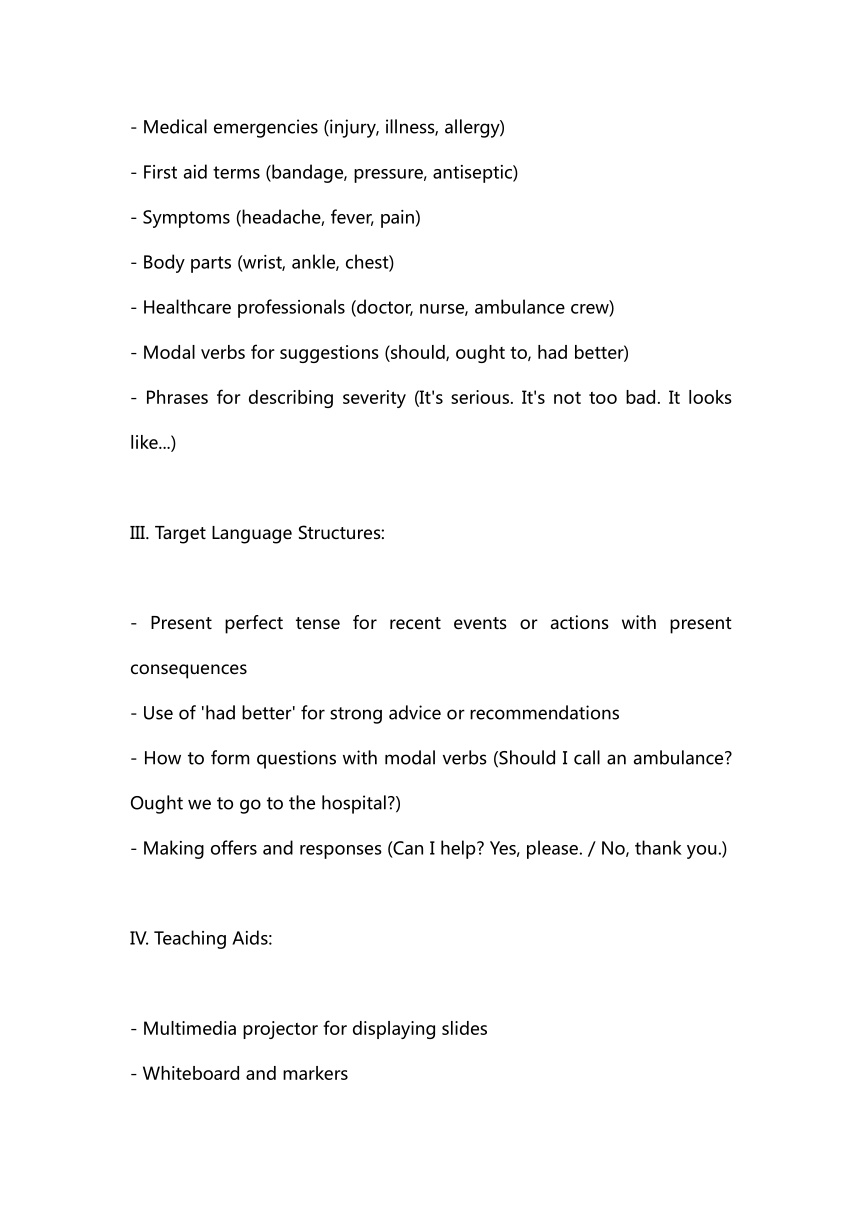Module 5 Unit 1 We'd better get you to hospital. 教案 2023-2024学年外研版九年级英语下册
文档属性
| 名称 | Module 5 Unit 1 We'd better get you to hospital. 教案 2023-2024学年外研版九年级英语下册 |  | |
| 格式 | docx | ||
| 文件大小 | 13.6KB | ||
| 资源类型 | 教案 | ||
| 版本资源 | 外研版 | ||
| 科目 | 英语 | ||
| 更新时间 | 2024-02-22 16:27:33 | ||
图片预览


文档简介
外研版九年级下册 Module 5 Unit 1 We'd better get you to hospital. 教案
I. Teaching Objectives:
By the end of this lesson, students will be able to:
1. Recognize and use key phrases related to giving first aid and medical emergencies.
2. Talk about health-related issues and describe symptoms coherently.
3. Utilize the present perfect tense to describe actions that have happened in the recent past.
4. Use modal verbs for making suggestions and expressing necessity.
5. Develop skills in listening, speaking, reading, and writing focused on handling medical situations.
6. Apply appropriate vocabulary to create dialogues and role-plays related to seeking medical help.
7. Demonstrate empathy and understanding when discussing sensitive health topics.
II. Key Vocabulary:
- Medical emergencies (injury, illness, allergy)
- First aid terms (bandage, pressure, antiseptic)
- Symptoms (headache, fever, pain)
- Body parts (wrist, ankle, chest)
- Healthcare professionals (doctor, nurse, ambulance crew)
- Modal verbs for suggestions (should, ought to, had better)
- Phrases for describing severity (It's serious. It's not too bad. It looks like...)
III. Target Language Structures:
- Present perfect tense for recent events or actions with present consequences
- Use of 'had better' for strong advice or recommendations
- How to form questions with modal verbs (Should I call an ambulance Ought we to go to the hospital )
- Making offers and responses (Can I help Yes, please. / No, thank you.)
IV. Teaching Aids:
- Multimedia projector for displaying slides
- Whiteboard and markers
- Picture cards illustrating medical scenarios and first aid kit contents
- Handouts with listening exercises, dialogues, and role-play scenarios
- First aid kit for real-life demonstration (if available)
- Role-play props (e.g., phone, fake injuries, etc.)
V. Teaching Procedures:
Step 1: Warm-up (5 minutes)
- Begin by asking students if they know what to do in a medical emergency. Elicit general knowledge of first aid.
- Introduce key vocabulary through quick flashcard drills and brief discussions.
Step 2: Pre-reading (5 minutes)
- Show images related to medical emergencies and ask students what they think should be done in each situation.
- Review the target language structures, focusing on the present perfect tense and modal verbs.
Step 3: While-listening (15 minutes)
- Play an audio recording featuring a conversation where someone is hurt and needs medical attention.
- Ask students to listen and identify the symptoms and the suggested course of action.
- After listening, hold a class discussion to clarify any misunderstandings and encourage students to share their thoughts on proper procedures.
Step 4: Post-listening (15 minutes)
- In pairs, students practice creating dialogues where they role-play a medical emergency scenario, using the target language structures to give advice and help.
- Walk around the classroom to provide assistance and ensure the accurate use of language.
Step 5: Speaking Practice (10 minutes)
- Using role-play props, simulate a medical emergency where one student must seek help from another. Encourage use of first aid vocabulary and modal verbs for advice.
- Some groups can perform their role-play for the class.
Step 6: Writing Task (10 minutes)
- Assign a writing task where students create a short paragraph describing a recent minor injury they or someone they know has experienced, including the steps taken for first aid and the outcome.
- Encourage students to use the present perfect tense and modal verbs in their descriptions.
Step 7: Homework & Review (5 minutes)
- Review key vocabulary and language structures by playing a game such as "First Aid Trivia," where students answer questions based on the lesson's content.
- Assign homework: Students research common household injuries and how to treat them, preparing a short presentation to share with the class.
VI. Assessment:
- Evaluate students' participation in discussions, listening exercises, and pair work to assess their understanding of vocabulary and ability to use the target language structures correctly.
- Check written assignments for correct use of present perfect tense, appropriate expression of symptoms, and clarity in describing medical situations.
I. Teaching Objectives:
By the end of this lesson, students will be able to:
1. Recognize and use key phrases related to giving first aid and medical emergencies.
2. Talk about health-related issues and describe symptoms coherently.
3. Utilize the present perfect tense to describe actions that have happened in the recent past.
4. Use modal verbs for making suggestions and expressing necessity.
5. Develop skills in listening, speaking, reading, and writing focused on handling medical situations.
6. Apply appropriate vocabulary to create dialogues and role-plays related to seeking medical help.
7. Demonstrate empathy and understanding when discussing sensitive health topics.
II. Key Vocabulary:
- Medical emergencies (injury, illness, allergy)
- First aid terms (bandage, pressure, antiseptic)
- Symptoms (headache, fever, pain)
- Body parts (wrist, ankle, chest)
- Healthcare professionals (doctor, nurse, ambulance crew)
- Modal verbs for suggestions (should, ought to, had better)
- Phrases for describing severity (It's serious. It's not too bad. It looks like...)
III. Target Language Structures:
- Present perfect tense for recent events or actions with present consequences
- Use of 'had better' for strong advice or recommendations
- How to form questions with modal verbs (Should I call an ambulance Ought we to go to the hospital )
- Making offers and responses (Can I help Yes, please. / No, thank you.)
IV. Teaching Aids:
- Multimedia projector for displaying slides
- Whiteboard and markers
- Picture cards illustrating medical scenarios and first aid kit contents
- Handouts with listening exercises, dialogues, and role-play scenarios
- First aid kit for real-life demonstration (if available)
- Role-play props (e.g., phone, fake injuries, etc.)
V. Teaching Procedures:
Step 1: Warm-up (5 minutes)
- Begin by asking students if they know what to do in a medical emergency. Elicit general knowledge of first aid.
- Introduce key vocabulary through quick flashcard drills and brief discussions.
Step 2: Pre-reading (5 minutes)
- Show images related to medical emergencies and ask students what they think should be done in each situation.
- Review the target language structures, focusing on the present perfect tense and modal verbs.
Step 3: While-listening (15 minutes)
- Play an audio recording featuring a conversation where someone is hurt and needs medical attention.
- Ask students to listen and identify the symptoms and the suggested course of action.
- After listening, hold a class discussion to clarify any misunderstandings and encourage students to share their thoughts on proper procedures.
Step 4: Post-listening (15 minutes)
- In pairs, students practice creating dialogues where they role-play a medical emergency scenario, using the target language structures to give advice and help.
- Walk around the classroom to provide assistance and ensure the accurate use of language.
Step 5: Speaking Practice (10 minutes)
- Using role-play props, simulate a medical emergency where one student must seek help from another. Encourage use of first aid vocabulary and modal verbs for advice.
- Some groups can perform their role-play for the class.
Step 6: Writing Task (10 minutes)
- Assign a writing task where students create a short paragraph describing a recent minor injury they or someone they know has experienced, including the steps taken for first aid and the outcome.
- Encourage students to use the present perfect tense and modal verbs in their descriptions.
Step 7: Homework & Review (5 minutes)
- Review key vocabulary and language structures by playing a game such as "First Aid Trivia," where students answer questions based on the lesson's content.
- Assign homework: Students research common household injuries and how to treat them, preparing a short presentation to share with the class.
VI. Assessment:
- Evaluate students' participation in discussions, listening exercises, and pair work to assess their understanding of vocabulary and ability to use the target language structures correctly.
- Check written assignments for correct use of present perfect tense, appropriate expression of symptoms, and clarity in describing medical situations.
同课章节目录
- Module 1 Travel
- Unit 1 We toured the city by bus and by taxi
- Unit 2 It's a long story.
- Unit 3 Language in use
- Module 2 Education
- Unit 1 They don't sit in rows.
- Unit 2 What do I like best about school?
- Unit 3 Language in use
- Module 3 Life now and then
- Unit 1 They sometimes work harder.
- Unit 2 I think life is better today.
- Unit 3 Language in use.
- Module 4 Rules and suggestions
- Unit 1 You must be careful of falling stones.
- Unit 2 we must keep the camp clean.
- Unit 3 Language in use.
- Revison A
- Module 5 Look after yourself
- Unit 1 We'd better get you to hospital.
- Unit 2 Get off the sofa!
- Unit 3 Language in use.
- Module 6 Eating togethe
- Unit 1 When is the school-leavers' party?
- Unit 2 Knives and forks are used for most Western
- Unit 3 Language in use
- Module 7 English for you and me
- Unit 1 Have you ever been to an English corner?
- Unit 2 We all own English.
- Unit 3 Language in use
- Module 8 My future life
- Unit 1 Here's to our friendship and the future
- Unit 2 I know that you will be better at maths.
- Unit 3 Language in use
- Revison B
